Nexera Gel Permeation Chromatography System - Features
GPC System
Increased Throughput by Overlapped Injection
Measuring molecular weight distribution of polymer compound by size exclusion mode is one of the typical parts of HPLC and generally called gel permeation chromatography (GPC). Nowadays there is an increasing demand demand for high throughput analysis even in well-established GPC. Here we introduce a novel GPC analysis that affords both high throughput GPC results by overlapped injection using conventional size of columns and simultaneous determination of polymer additives.
GPC Analysis by Overlapped Injection and Simultaneous Determination of Polymer Additives
A refractive index detector (RID) that gives a response to a sample weight is commonly employed for GPC to calculate average molecular weight and polydispersity. On the other hand, A UV detector is used for determination of polymer additives such as antioxidants. Consequently, serially connected those two detectors were used for this study. In GPC, there is hardly any eluates prior to exclusion limit. So if the sample elution band from previous injection is managed to be overlapped within this no elution interval in present analysis, short analysis cycle time can be obtained and it provides increased throughput in sequential analyses. When two or more polymer additives are contained, correct determination of those small additives is difficult because complete separation of additives is almost impossible even using GPC columns of small exclusion limit due to small difference of molecular weight among those polymer additives. To address this difficulty, a photodiode array detector (PDA) that affords spectrometric information as well as chromatographic results was employed to give increased separation of polymer additives by peak deconvolution function within a single GPC analysis.
Fig. 1 and Table 1 show obtained chromatogram of polystyrene containing three antioxidants and employed analytical conditions respectively.
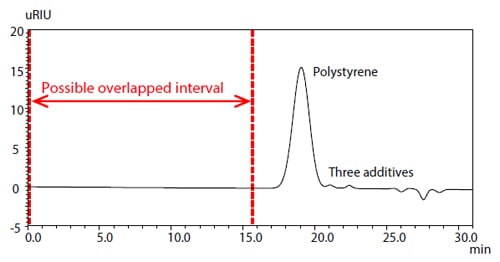
Fig. 1 Chromatogram of Polystyrene and Three Additives (RID)
| Table 1 Analytical Conditions | |
|---|---|
| Column |
Shim-pack™ GPC 805+GPC 801
(300 mmL. × 8 mmI.D. for each)
|
| Mobile phase | THF |
| Flow rate | 0.8 mL/min |
| Column temp. | 40 °C |
| Injection vol. | 10 μL |
| Detection | RID / PDA (220-400 nm) |
| Sample | 0.5 % Polystyrene containing three additives |
| Cycle time | 31 min |
| Overlap time | 15.5 min |
Increased Throughput by Overlapped Injection
Based on the chromatogram in Fig. 1, 0 to 15.5 term was assigned to overlapped interval due to no elution during it. Fig. 2 shows the comparison of sequential chromatograms obtained with/without overlapped injection. Almost 50 % of decreased analysis cycle time provided increased throughput of sequential GPC analyses.
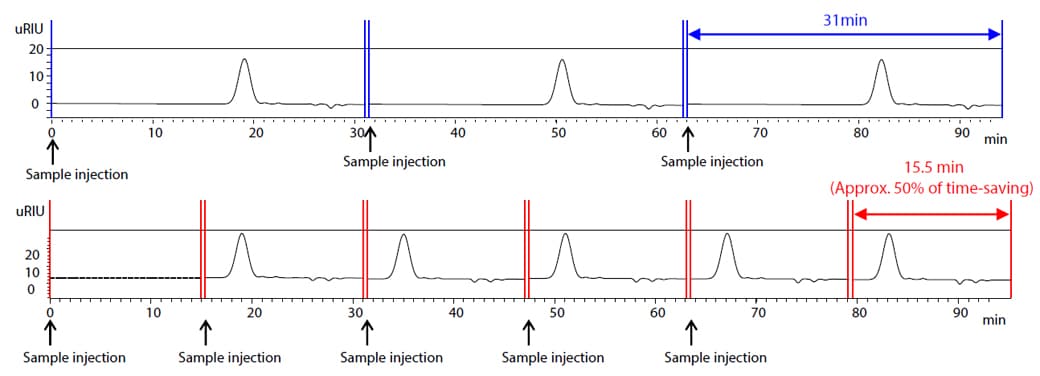
Fig. 2 Comparison of Sequential GPC Analyses With (Lower) / Without (Upper) Overlapped Injection (RID)
Ensures Highly Reliable Analysis Regardless of Operator Skill Level
Protects Expensive GPC Columns:FlowPilot 
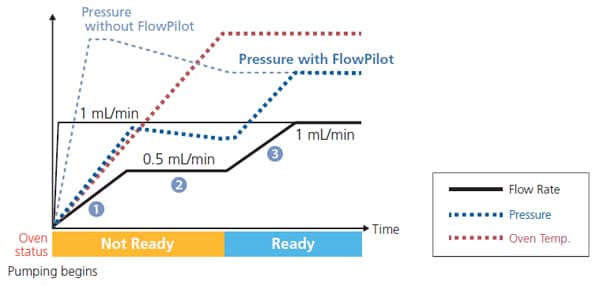
HPLC columns can be damaged by sudden pump starts and stops or extreme gradient changes. The Nexera automatically uses FlowPilot (Smart Flow Control) to increase the flow rate gradually to the set point. There is no need to create startup protocols for each analysis.
Mobile Phase Levels Measured in Real Time 
Reservoir tray weight sensors (optional) can be used to monitor the volume of mobile phase or autosampler rinse solution in up to twelve containers. The containers can also be checked remotely from a smart device. You will no longer need to worry about running out of mobile phase mid-analysis, because the device will notify you before starting the run if the volume remaining is too low.
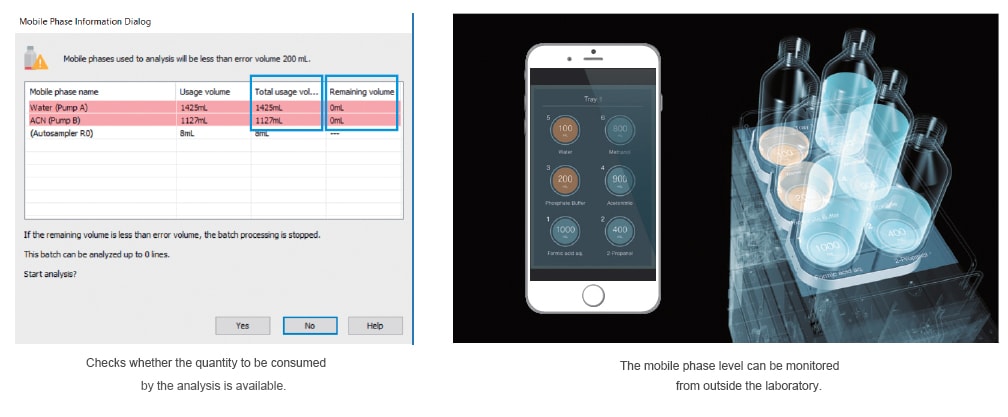
Auto-Diagnostics and Recovery 
In rare cases, air bubbles can form in the mobile phase and cause problems if inhaled into the pump. The Nexera has the ability to monitor baseline changes and pressure fluctuations to check for abnormalities. When it detects an unusual fluctuation, it can automatically pause the analysis, purge the flow path, and restart analysis once it has confirmed recovery to normal pressure.
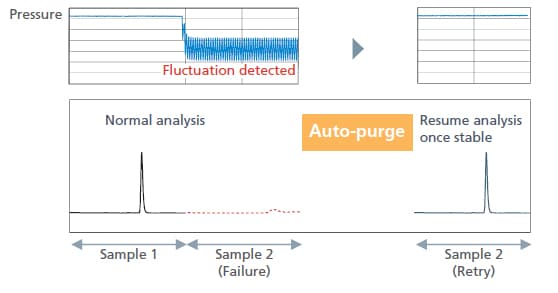
Automated Workflow 
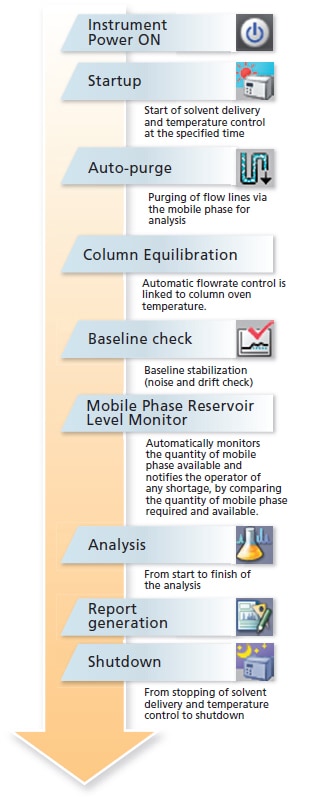
Functionality for assisting the entire series of analytical process steps, from instrument startup to shutdown, significantly increases work efficiency. FlowPilot mobile phase flowrate control functionality is linked to column oven temperature, so that columns are protected during automatic column equilibration. By automatically checking for baseline drift, instrument stability is maintained without the operator having to remain next to the instrument.
Easy Analysis of Molecular Weight Distribution via Graphical Interface
Create a Calibration Curve in Just Three Steps
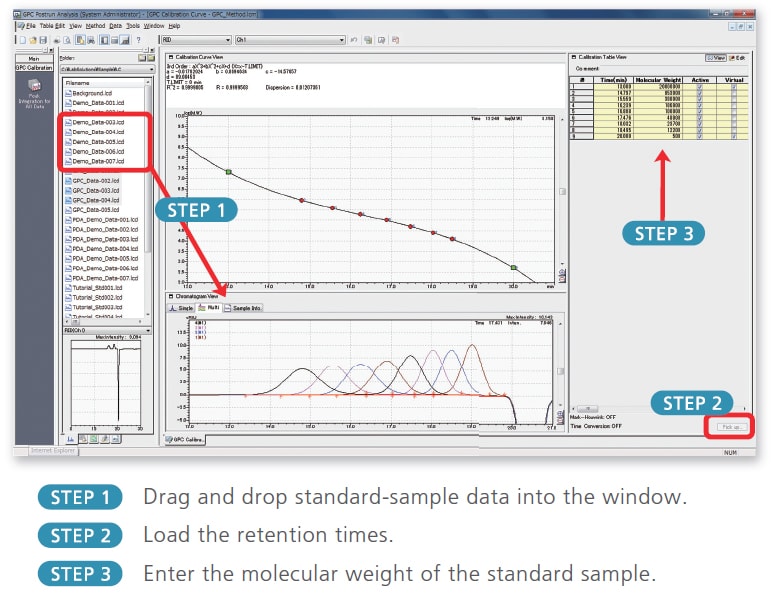
A maximum of 64 data points are available. Virtual points are also easy to set, and calibration curve appropriateness can be checked visually while choosing from a wide variety of approximation equations. Calibration curves can be corrected using the Mark-Houwink equation, and other correction methods based on Q-factors or degree of polymerization are available.
Graphical GPC Data Analysis Window
- Manipulation of peak integration possible by means of the graphical interface
- Management of data from multiple detectors within a single file
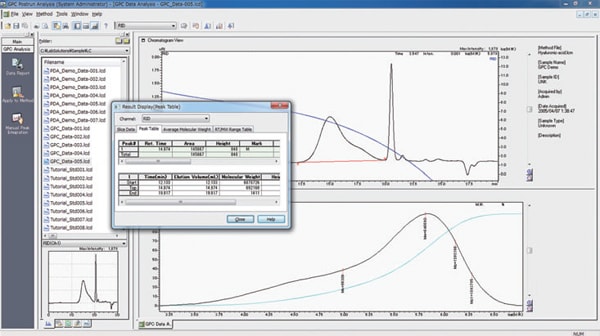
Because the molecular weight distribution curve is updated whenever peak integration is performed, results for mean molecular weight, intrinsic viscosity, polydispersity, and other parameters can be confirmed immediately. Time and detector sensitivity can also be corrected based on an internal standard peak or control sample.
The Data Comparison Window Allows Simultaneous Evaluation of Multiple Samples
- The elution curves and derivative and integrated molecular weight distribution curves for up to 10 samples can be overlaid on a graph.
- Statistical results can be displayed for mean molecular weight, intrinsic viscosity, and polydispersity.
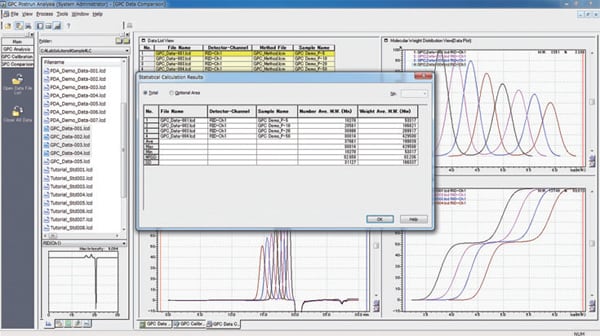
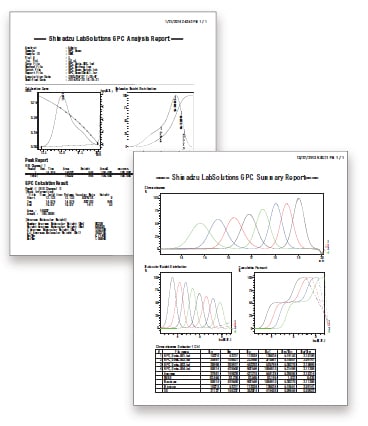
Diverse Range of Report Formats
LabSolutions is equipped with report templates for a variety of analysis results. The software can accommodate a diverse range of reports thanks to a wealth of report items and a highly flexible layout. In addition, a PDF output function is included as standard, so analysis results reports can be managed by automatic import to a database, helping your laboratory to go paperless, and promoting an eco-friendly analysis process.
Reduce the Work Involved in Creating a Final Report
Do you move your analytical results to a spreadsheet program (e.g., Excel®) to create a final report?
LabSolutions includes a multi-data report feature, which reduces the work involved in report creation. Analytical results are automatically entered into a spreadsheet equivalent to the one used in Excel, eliminating the need to move the data.
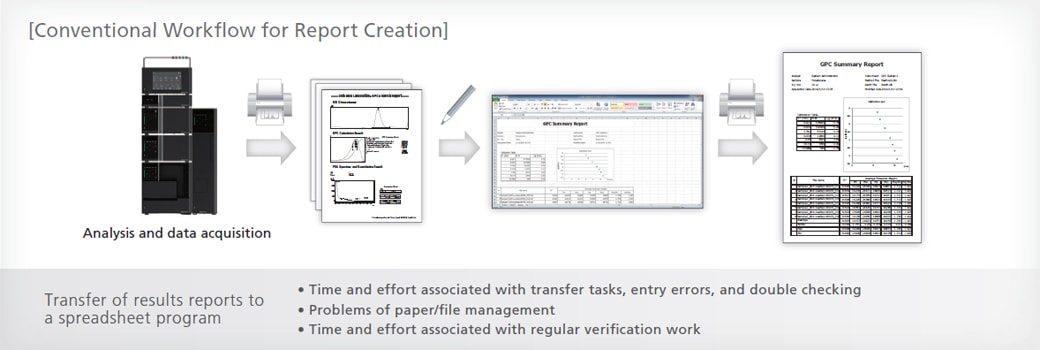
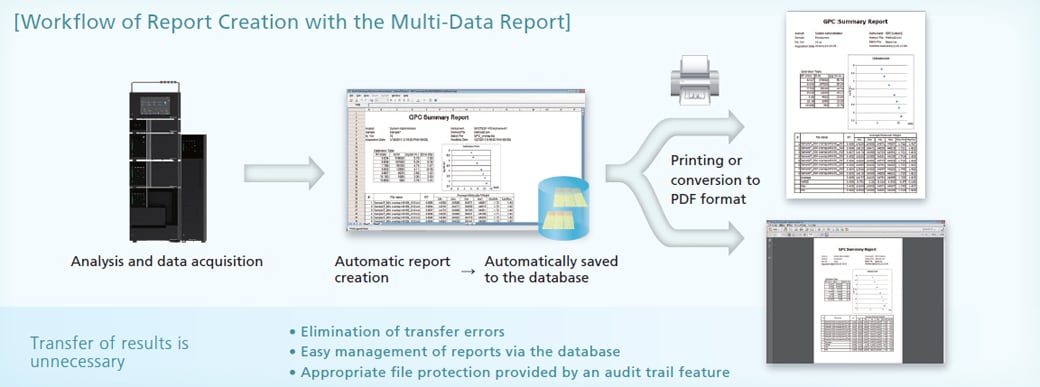

ANALYTICAL INTELLIGENCE
- Automated support functions utilizing digital technology, such as M2M, IoT, and Artificial Intelligence (AI), that enable higher productivity and maximum reliability.
- Allows a system to monitor and diagnose itself, handle any issues during data acquisition without user input, and automatically behave as if it were operated by an expert.
- Supports the acquisition of high-quality, reproducible data regardless of an operator’s skill level for both routine and demanding applications.


